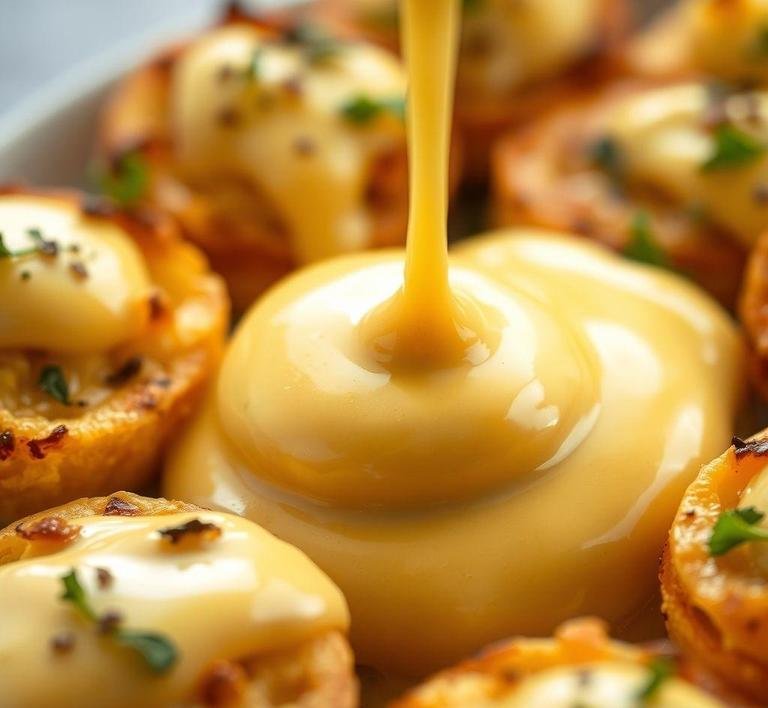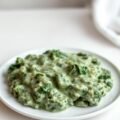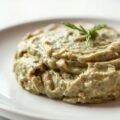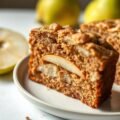Jamie Oliver’s Cheese Sauce is a rich, creamy and flavorful sauce that’s perfect for all sorts of dishes-mac and cheese, cauliflower cheese or even drizzled over roasted veggies. It’s simple yet delicious, with a beautiful balance of smooth cheese and velvety texture. This sauce is famous for its comforting taste and the fact that it’s incredibly versatile. Jamie’s recipe tends to stick to classic ingredients, giving you a foolproof method for creating that indulgent, cheesy goodness everyone loves.
Jamie Oliver Cheese Sauce Recipe
Ingredients Needed
You don’t need anything fancy for this cheese sauce. Jamie keeps it pretty straightforward, relying on the basics:
- Butter: This gives the sauce its richness and helps in making the roux (flour-butter mix) that thickens the sauce.
- Plain Flour: Essential for thickening. You’ll be using it to make a roux with the butter which forms the base of the sauce.
- Milk: The liquid that turns the roux into a smooth, pourable sauce. Whole milk is often preferred for that extra creaminess.
- Cheese: The star of the show! A good sharp cheddar is Jamie’s go-to but you can mix it up with others like Gruyère or Parmesan to add extra depth.
- Mustard Powder (optional): Adds a little zing to balance out the richness. It’s not always in the recipe but gives a nice kick if you want it.
- Salt and Pepper: For seasoning. A pinch of each is usually enough but adjust to your taste.
Equipment Needed
When it comes to making cheese sauce, you won’t need much in terms of tools. Here’s what you’ll need:
- Saucepan: A medium-sized pan works best for cooking the roux and the sauce. You don’t want it too big or the sauce might evaporate too quickly.
- Whisk: This is essential for keeping the sauce smooth and lump-free as it cooks.
- Grater: If you’re using block cheese (which I recommend for the best texture), you’ll need to grate it yourself. Pre-grated cheese often has anti-caking agents that can affect the sauce’s consistency.
- Measuring Spoons: For the mustard powder, salt and pepper, it helps to measure things out so the flavors are balanced.
How To Make Jamie Oliver’s Cheese Sauce
Making Jamie Oliver’s Cheese Sauce is all about creating a smooth, creamy base that melts beautifully. Here’s a breakdown:
- Make the Roux: Start by melting butter in your saucepan over medium heat. Once it’s melted, add in the flour and stir constantly to create a smooth paste. This is your roux which will thicken the sauce. Cook it for a minute or two to get rid of any raw flour taste but don’t let it brown.
- Add Milk Gradually: Slowly pour in the milk, little by little, whisking all the time. This helps avoid lumps. Once all the milk is in, keep whisking until the sauce thickens and becomes velvety smooth.
- Stir in the Cheese: When the sauce has thickened (after about 5-7 minutes), reduce the heat and start adding your grated cheese. Stir until it’s completely melted and smooth. If you want extra creaminess, you can add a knob of butter at this stage.
- Season: Taste the sauce and adjust with salt, pepper and a little mustard powder if you’re using it. This step is important because the cheese can be quite salty on its own, so taste testing helps you get the balance right.
- Serve: Once it’s smooth, rich and cheesy, it’s ready to be poured over pasta, vegetables or whatever your heart desires.
What I Learnt

What I really love about Jamie Oliver’s Cheese Sauce is how adaptable it is. You can tweak the flavor by using different cheeses or adding herbs or spices. The key takeaway is that the texture really depends on how carefully you make the roux and add the milk. If you rush, you might get lumpy results. The other thing? Don’t skimp on the cheese-using a high-quality cheddar or even mixing a few types elevates the sauce to another level. Also, patience is essential when whisking; it’s all about creating a smooth, lump-free sauce that coats whatever you’re putting it on.
Recipe Tweaks For Jamie Oliver’s Cheese Sauce
Jamie Oliver’s cheese sauce is already pretty stellar but there’s always room for a personal touch. Here are some tweaks that can elevate your cheese sauce to the next level.
-
Add a Dash of Mustard
A little bit of mustard (Dijon or English) adds a sharp tang that balances the richness of the cheese. It’s not overpowering but gives the sauce a deeper, more complex flavor. Add it in after the cheese has melted in, so it integrates smoothly.
-
Spice It Up
If you love heat, toss in a pinch of cayenne pepper or chili flakes. The subtle heat won’t overwhelm the sauce but it’ll add an unexpected kick that works especially well with milder cheeses like cheddar or gouda.
-
Swap the Milk for Cream
For an ultra-creamy sauce, substitute the milk with heavy cream or half-and-half. This will give the sauce a richer, silkier texture, perfect if you’re making a special occasion dish like mac and cheese.
-
Cheese Variety
While Jamie’s original recipe uses mature cheddar, why not play around with different cheeses? Gruyère or Parmesan will give the sauce a more nutty flavor while a combination of blue cheese and cheddar can create a funky, indulgent sauce. Mixing in some mozzarella? Expect a stretchy, gooey delight.
-
Garlic and Herbs
Infuse some garlic into the butter before making your roux. Sauté a clove or two of minced garlic until fragrant, then proceed with the recipe. Fresh herbs like thyme or rosemary, finely chopped, can also be stirred in for added depth.
-
Nutmeg and Lemon Zest
A sprinkle of nutmeg is classic but try adding some lemon zest for a refreshing twist. It cuts through the richness and adds a burst of citrus that balances the heaviness of the cheese.
Storage Tips For Leftovers
Cheese sauce is a dish that can go on for days when stored properly. To keep that velvety, cheesy goodness intact, follow these tips:
-
Cool It Quickly
If you’re not going to use all of the sauce, cool it as quickly as possible. Spread it out in a shallow dish or place the pot in a sink of ice water to reduce the temperature fast. This helps prevent bacterial growth and keeps the texture from breaking down.
-
Store in an Airtight Container
Once cooled, transfer the sauce to an airtight container. The better the seal, the longer it’ll last in the fridge. Stored this way, your cheese sauce should stay fresh for about 3-4 days.
-
Reheat Gently
When you’re ready to use it again, reheat the sauce slowly on low heat. Stir constantly to prevent it from separating or becoming too thick. If it’s too thick, add a splash of milk or cream to bring it back to life.
-
Freezing Leftovers
Cheese sauce can be frozen but there’s a slight risk that it might separate upon thawing. To freeze, let the sauce cool completely, then pour it into a freezer-safe container. You can store it for up to 3 months. When you’re ready to use it, thaw overnight in the fridge and gently reheat.
-
Avoid Freezing If You Used Cream
If you added heavy cream, the texture might suffer a bit after freezing and reheating. The sauce can become grainy or split. It’s still edible but it won’t have that smooth, silky finish. For a cream-free version, freezing works much better.
What To Eat With Jamie Oliver’s Cheese Sauce?
Jamie Oliver’s cheese sauce is super versatile and can enhance so many dishes. Here are a few mouthwatering ideas:
-
Mac and Cheese
The classic combo. Pour that cheese sauce over cooked pasta (elbow macaroni or cavatappi work best) and bake with a crispy breadcrumb topping for a decadent treat. Add some cooked bacon or sautéed mushrooms for extra flavor.
-
Vegetables
Cheese sauce can take a basic vegetable dish to new heights. Pour it over steamed broccoli, cauliflower or roasted Brussels sprouts. You could also use it as a dip for raw veggies like carrots and celery, turning an ordinary snack into something irresistible.
-
Fish
It might sound a bit indulgent but try it over baked white fish like cod or haddock. The richness of the sauce pairs beautifully with the delicate flavor of the fish. Serve with a side of mashed potatoes or a light salad for balance.
-
Grilled Chicken
Drizzle the cheese sauce over grilled or roasted chicken breasts for a simple yet flavorful meal. Add some sautéed spinach or caramelized onions to round out the dish.
-
Baked Potatoes
Cheese sauce is the perfect topper for baked potatoes. Load them up with sour cream, crispy bacon bits and chives for a hearty meal.
-
As a Sandwich Spread
Why not spread the cheese sauce on a sandwich? Use it as a dip for hot sandwiches like a grilled cheese or spread it on a toasted baguette with some roasted veggies and chicken for a gooey, flavorful bite.
FAQs
What’s The Secret To Jamie Oliver’s Cheese Sauce Being So Creamy?
The trick is using a mix of butter, flour, and whole milk to create a smooth roux before adding cheese. It’s all about getting the consistency just right!
Can I Make Jamie Oliver’s Cheese Sauce Ahead Of Time?
Yes, you can! Just store it in an airtight container and reheat gently, adding a splash of milk if it thickens up too much.
What Type Of Cheese Does Jamie Oliver Recommend For His Cheese Sauce?
Jamie typically uses a mix of cheddar and Parmesan for a balance of creamy texture and strong flavor.


